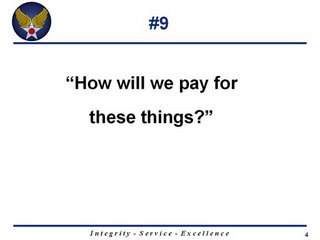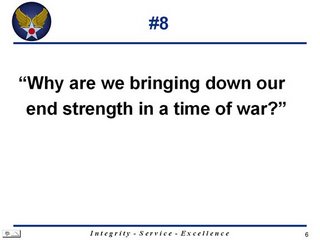
See Part 1 HERE
We now continue deconstructing the AF's 'Force Reshaping' proposal.....
"People Costs" Ain't the Problem

Another good question! What is the answer?

Gee, it almost reads as if the AF contracted with Scott Adams to deliver them a “Mission Statement Generator”. And it doesn’t look like they mean to 'take care of the Airmen' in the traditional sense so far……

Now Question 8 above is a REALLY good one!

Surprise!-- It’s a Money thing. Not surprised? Me neither.
So does the AF thinks it is spending too much on people in their slice of the defense budget? Let’s look at the evidence they present……hmmmmmm. Nope, no useful data here, but it is a hell of a sales graphic as well as a great “dumbed down for management” slide. What’s wrong with this chart?
1. This represents only ‘people dollars’.
2. ‘People dollars’ have absolutely nothing to do with any other costs, in that Congress provides funds for these costs separate and distinct from other costs. Call it ‘earmarked’, but we (former) ‘acquisition officials’ see it as in different pots (or buckets) of money.
3. Congress sets the amount and DIRECTS the expenditure of these funds as ‘people dollars’.
4. If the DoD spends the money for any other purposes without an OK from Congress then somebody goes to jail.
Congress "Supports the Troops"
Is the AF being pressured by Congress to reduce manpower costs?
NO.
Not really....
Even if you could find a quote that says otherwise.
How do we know this? Because on behalf of an appreciative nation and to help combat the impact of inflation on the individual troop and employee, Congress keeps giving military and civilian DoD employees something called ‘Raises’. How big are the raises? Big enough that most of that rise in costs after 1995 could be largely accounted for by raises in base pay alone: 49+% for military personnel and 34+% for civilian employees (see charts below).


And none of what I’ve mentioned so far accounts for increases in Per Deim, Housing Allowances, Locality Pay: all of which have increased as well.
Most years, raises are generally not any bigger than before, it’s just that (for the years shown on this chart) the increases in pay until 1995 were being offset by reducing the number of people. Stop reducing numbers of people and the impact of raises on total personnel costs becomes apparent. If chart 7 above alarms you, then you are also probably sit around wondering why it is our prison population continues to grow as the crime rate drops.
A few other things jump out here. The fusion of civilian and military pay numbers is no accident. The aging Civil Service force is a ‘Senior’ force in more ways than one: The GS force is so top-heavy with the highest paid people reaching retirement age that the exodus isn’t expected to peak until around 2008-2009 (just off this chart ‘coincidentally’).
We need not go into all the other congressionally-directed changes to the compensation schemes in detail, but here’s one other to consider. Congress has also raised “pay caps” in the period of ‘concern’. While some federal employees make X amount of money according to the pay charts, the actual amount paid out is limited to a specified level (X minus Y), so that the most senior (and costly) military and civilians are actually getting more of what they are supposed to get in the first place. It is very complicated (It IS Congress we’re talking here) so if you want to know more about this quirk you can go here and here to begin your exploration of the wonderful world of government compensation.
With the exception of pay raises, much of what I’ve pointed out has to pale in comparison to the impact of a little thing called Ops Tempo. Note how Operation Allied Force (’99) doesn’t even cause a blip on the cost line, and how the slope really increases in 2001. 2001….2001…..something big started happening in 2001. (Oh yeah, now I remember!) What percentage of this perceived increase can be directly attributed to operations in Afghanistan, Iraq and elsewhere?
There are some quirks to the indirect and overhead personnel cost accounting we could ponder, but you get the point. All things considered, I want to know how the AF is keeping personnel costs so low!
As you can tell from the left hand side of this slide, the presenters are leading up to the real concern that needs attention: the hardware. That someone at the SecAF level seems to think that there is any correlation between people costs and hardware costs anywhere inside the mind of the typical Joe Congressman is disturbing. That someone or someones ALSO thinks that by marketing a plan that sacrifices PEOPLE on the budgetary altar they can somehow gain direct and proportional favor from the "budgetary gods" to fulfill their future hardware needs is LUDICROUS: No bargain made with a previous Congress (or with the Devil) has ever meant a damned thing to the NEXT Congress or Congress after that.
Somebody! Please, PLEASE fire the Effin’ MBAs and Bring Us Some Leaders! --Rumor has it the Marines still have a few.
In the next installment: We get a little ‘Technical’.
Part 3 HERE
No comments:
Post a Comment
Older posts are moderated only to keep the spambots and time wastrels away. If you are not a spambot or a wastrel, your comment will be posted. Egregious behavior and abusive comments will be initially critiqued. Persistence in egregious behavior and abusive comments will be cut off as deterrence to time wastrels.
Added 28 Sep 13: Comments without specific reference to subject posts that contain links to commercial enterprises also unrelated to subject post will be summarily deleted and reported as SPAM